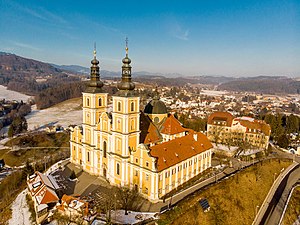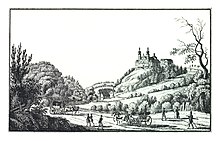Mariatrost
|
|||
| Basic data | |||
| Surface: | 13.99 km² | ||
| Residents: | 9,769 (January 1, 2017) | ||
| Population density: | 698 inhabitants per km² | ||
| Postcodes: | 8043, 8044 | ||
| Geographical location: | 47 ° 6 ′ N , 15 ° 29 ′ E | ||
| Location in Graz | |||
| District Office: | Stiftingtalstrasse 3 8010 Graz |
||
| District Head: | Erwin Wurzinger ( ÖVP ) | ||
| 1. Deputy District Head: | Alexander Trojovsky ( Greens ) | ||
| 2nd deputy district head: | Helmut Schwab ( KPÖ ) | ||
| Public transportation: | Tram line 1, bus lines 58, 81, 83 N1 |
||
| photo | |||
| Mariatrost Basilica | |||
Mariatrost (formerly Maria Trost ) is the 11th district of the city of Graz .
history
Until the 1930s, the name Maria Trost, known from the pilgrimage , hid behind the rather unknown community name Fölling. Shortly before it was incorporated into Graz, there was also a legal market community of Maria Trost with the cadastral communities Wenisbuch and Fölling. Wenisbuch comprised the villages of Kroisbach, Rettenbach, Maria Grün and the group of houses at the foot of the Mariatroster Kirchberg, plus the village of Wenisbuch itself and the area to the side of Mariatroster (Reichs-) Straße, including the plate . The main features of this classification remained in some areas, such as B. in the emotional sense of belonging of the old Mariatroster to this day.
In 1937 there were two dozen independent associations in the Maria Trost market. In the community there was the Wenisbuch electricity company and the volunteer fire brigade with the center in Kroisbach and departments in Maria Trost and Fölling. The Maria Grün sanatorium (now House of the Child, Schönbrunngasse 30) and the Maria Trost sanatorium (now the Blümelhof State Youth Home, Blümelhofweg 9–11) were among the best-known institutions of this type in the Graz area. The last mayor was Franz Herzog, after whom a path in the Neusitzgraben was named.
In 1938 the municipality of Maria Trost was connected to parts of the Geidorf district and declared the "North-East administrative unit of Greater Graz". In 1946 Mariatrost was split off from Geidorf and since then it has been the official 11th district of the city of Graz with an area of approx. 14 km².
geography
The south-western border to the Geidorf district is Schönbrunngasse, which runs from Hilnteichstraße to the Franzosenkreuz. A part of Mariatrost is also Mariagrün with the idyllic Mariagrün Church (where Peter Rosegger married ) in the middle of the Mariagrün forest. The Peter-Rosegger-Gedenkweg ends just a few meters below the church. It leads halfway along Mariagrüner Straße through the forest and is intended to stimulate thought with several quotes from Peter Rosegger.
The northern boundaries are formed by the rather gentle elevations of the Hauenstein (650 m) and the Platte (651 m), up to the eastern part of the Rosenberg (Ferdinandshöhe, 490 m) to the west of Mariatrost. The south-eastern border runs from Hilnteich , which no longer belongs to the district, to the Graz regional hospital and along the Roseggerweg in the direction of the Mariatrost Basilica .
On the outer borders of the district are two important local recreation centers of Graz, the Leechwald in the south and the Platte in the north. A popular destination is the Rettenbachklamm between Platte and Kogelberg .
At the foot of the Kirchberg of Mariatrost ( Purberg ) there is a pond that is used as a fish pond in summer and as an ice rink in winter.
traffic
The entire district is crossed in the valley by the B72 (Weizer Straße) . It bears the street name Mariatroster Straße and is the main artery of the district. The only other main street is Hilnteichstraße, which is only partially in the district. Otherwise there are only smaller roads that meander through the settlements, hills and forests of the district.
The most important line in public transport is tram line 1 of the Graz Linien . Coming from Hilnteich, it crosses the district along the Mariatrosterbach to the terminus at the Mariatrost Basilica or the Graz Tramway Museum . From the Mariagrün stop, the line runs on a pure tram route and is therefore completely independent of road traffic. The R23 cycle path runs parallel to this.
On Mariatrosterstraße, ÖBB post buses run in the direction of Weiz and in the direction of Schöckl . In addition, the Nightline N1 of the Graz Linien runs here on weekends in the direction of Park & Ride Fölling. Another line of the Graz Linien is the bus number 58, which runs from Mariagrün in the direction of the university, Lendplatz and the main train station. The Gersin company also operates lines 81 and 83, which run from Mariagrün via Rosenhain and Platte, respectively.
Culture and sights
Buildings
- Mariatrost Basilica: The Mariatrost pilgrimage church is the district's landmark.
- Mariagrün Church: In the small, idyllic church in Mariagrün, Peter Rosegger married in 1873.
- Tramway Museum Graz: The museum houses over 30 vintage trams, which can be viewed on guided tours and used for special trips. The museum was founded in 1971.
Nature reserve
The Bullmanngrund biotope protection area is a plant protection area with more than 250 native plant species. It is located in the Wenisbuch cadastral community at Am Josefbach 32. According to the announcement of nature conservation, the reason for the protection is the biodiversity of these plant communities, which are located in differently structured habitats and are interlocked like a mosaic. The protected area is approx. 8200 m².
Others
- Peter Rosegger Memorial Trail: The memorial trail in honor of the Styrian poet, located in the Mariagrünerwald, was opened in 2005.
- Rettenbachklamm: In the transition of the materials slate and phyllite, the Rettenbach (Steinbach) formed this small but impressive gorge . It is characterized by its gorge and torrent character and is treated as an “insider tip” by hikers. Its preservation is primarily because it is not marketed for tourism and is constantly maintained by the Graz Mountain and Nature Guard. The gorge is crossed by numerous wooden bridges and footbridges. After the floods in 1963 and 2005, the gorge was blocked.
- Educational forest trail in the Leechwald : The educational trail in the Leechwald leads from St. Johann to Hilnteich. 25 different trees are described along this path.
- Bach nature trail along the Mariatrosterbach: The Mariatroster Bach adventure trail was designed and built in 1999 as the first Bach trail in Graz by the For Nature association . It starts at the St. Johann tram stop and takes you along Erich-Edegger-Weg to the Teichhof tram stop. At four stations with 14 information boards and three sensory objects, visitors are given a wide range of information on the subject of Bach .
- Eugenie-Schmiedl-Hain Ecopark: The Eugenie-Schmiedl-Hain is a natural recreation area for the population of Graz. It offers the flora and fauna a variety of habitats ( biotope types ).
- Kroisbach Castle
- St. Josef Castle
- St. Johann Castle
- Hilmwarte
- Stephanienwarte : The 18-meter-high observation tower on the summit of the Platte was built in 1880 and named after Princess Stephanie , the wife of Crown Prince Rudolf . In 1977 the fire brigade association installed a radio device in the tower. In 1989, the air quality monitoring of the State of Styria set up a meteorological measuring point and in 1991 this was expanded to include an ozone measuring point . In 1995 the ARBÖ took over this radio location. In 1999 a new ozone meter was installed.
- Johanneskapelle / Pastoral Care Center Kroisbach
- Mariagrün eco farm
- Lassenstein Park
- The fire station Kroisbach / Mariatrost was handed over in 2009 by the professional fire brigade to the volunteer fire brigade Graz as a base
Others
- On the occasion of “Graz 2003 - European Capital of Culture”, the Mariatrost district initiated together with the “17 Graz cultural districts” a district film entitled “Mariatrost - Jewel of Graz”. In this half-hour video, the district presents itself from various perspectives. The screenwriter and director was ORF Styria editor Reinhart Grundner . Cinematographer Gunther Pöschl shot about a year in order to be able to capture all seasons and the most important activities on film.
- A hiking map (1: 12,500) with an aerial photo of the district was issued in June 2001 by the Alpine Association of Styria (Graz section), the Graz city group of the mountain and nature watch, the property management of the city of Graz and some sponsors.
Web links
Individual evidence
- ↑ Numbers + facts: population, districts, economy, geography on graz.at.
- ↑ a b c District councils in the Mariatrost district on graz.at ( Memento of the original from March 13, 2013 in the Internet Archive ) Info: The archive link was automatically inserted and not yet checked. Please check the original and archive link according to the instructions and then remove this notice.
- ↑ Ordinance of the mayor of the provincial capital Graz of April 22, 2013 regarding the protection of parts of the properties No. 948/1, 950/1, 948/4, KG Wenisbuch. Zl. A 17-046840 / 2008/0010. Grazer Zeitung, Official Gazette for Styria, 209th year 2013. 21st issue, issued May 24, 2013, in force from May 25, 2013. ZDB -ID 1291268-2 pp. 287–289.





